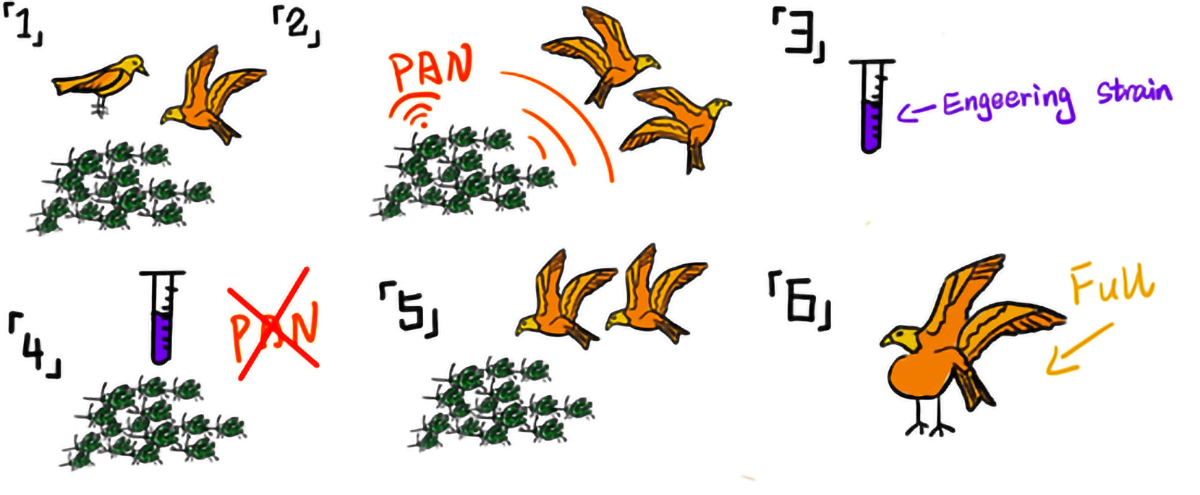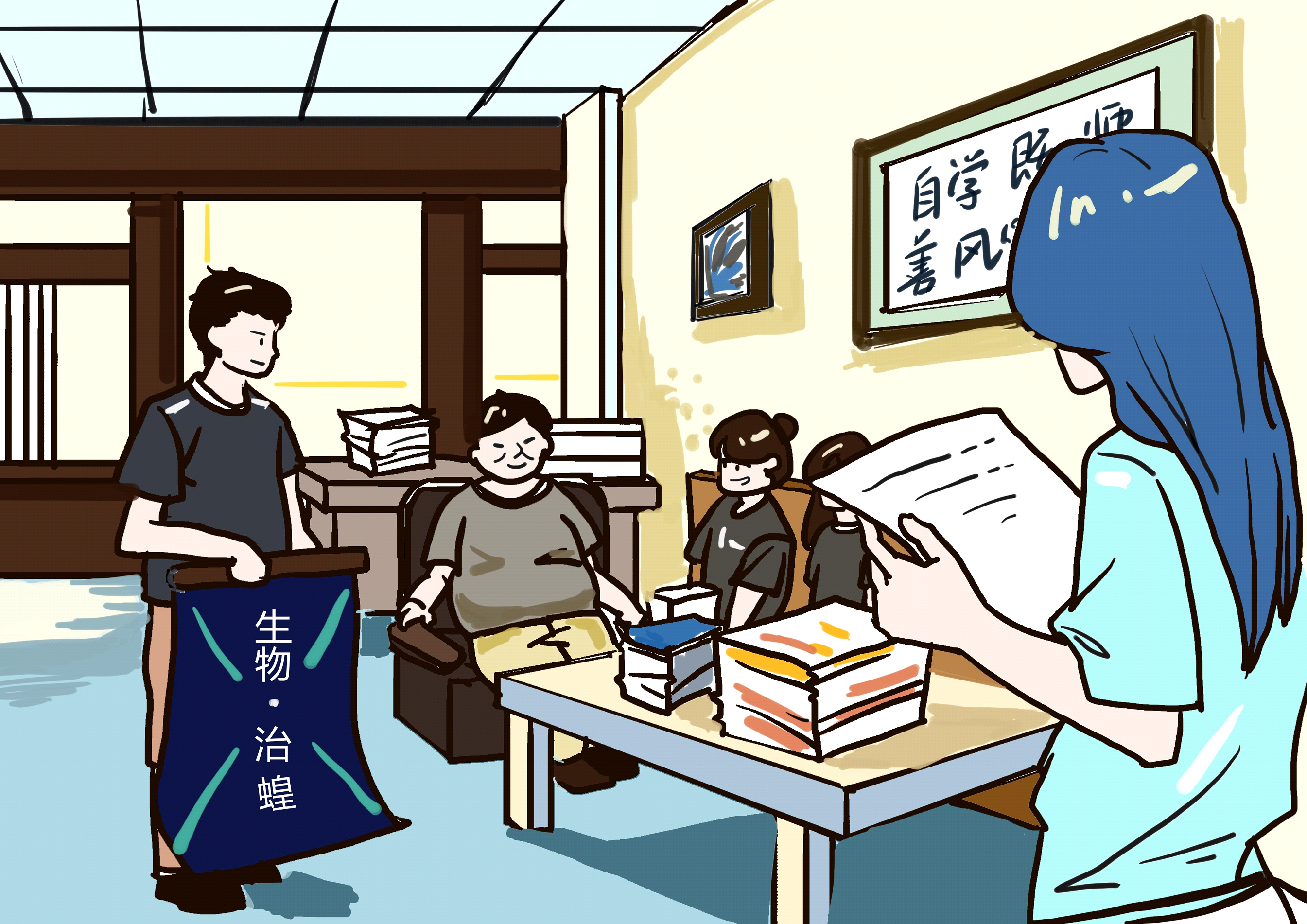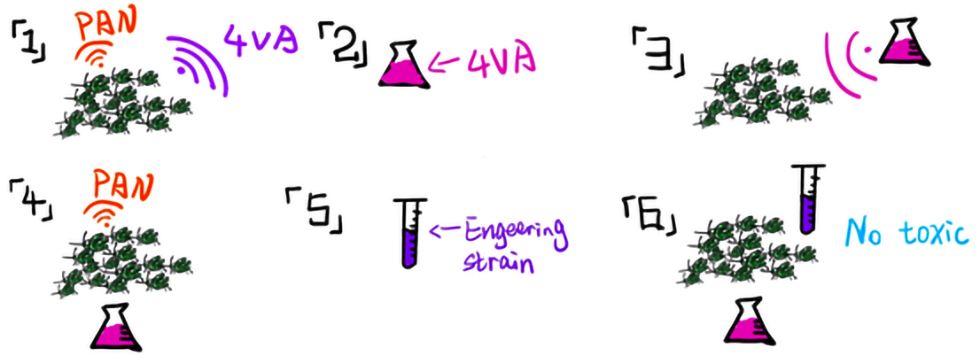<!DOCTYPE html>


Home

Team

Project

Results

Judging

Part

HP

Lab
Home
Results
Judging
Overview
Throughout the project, our team actively got feedbacks from two professors in CAS, and therefore altered our project design and conducted science communication activities. Moreover, we collected feedbacks from farmers, who are highly related to our project design, and gain insight of our model.

Interview with professor Kang Le
What is our previous project design?
As a team dedicating synthetic biology to control locust plagues, we have been paying a lot of attention to various research progresses on locusts. In the initial literature research, we found an article called "Phenylacetonitrile in locusts facilitates an antipredator defense by acting as an olfactory aposematic signal and cyanide precursor" published by the Kang Le's team. The paper mentioned phenyl acetonitrile as HCN's precursor. Therefore, the degradation of the precursors of locusts may effectively destroy the defense mechanism of locusts, thereby achieving the purpose of effective control of locusts.
At the same time, the essay also mentioned that benzyl cyanide has an aggregation effect on locusts, so the degradation of benzyl cyanide can achieve a dispersing effect on locusts to eliminate locust plagues. Although there has always been controversy in the scientific community as to the cause of the locust plague, the team determined the project at that time to manufacture engineering bacteria that can efficiently degrade benzyl cyanide.
There are two reasons for consideration:
- As mentioned in the article, benzyl cyanide acts as a chemical signal to change the predation preference of predators. Therefore, we expect that the efficient degradation of benzyl acetonitrile can adjust predators' predation preferences and achieve biological control.
- Phenylacetonitrile is the most abundant component of locust's volatile substances, so it can be speculated that it plays a decisive role in the signal transduction of locusts.

What made us change the plan?
In June, we learned that Doctor Le Kang's team published a new paper in Nature magazine, which established the status of 4VA as the only gathering pheromone of locusts. The importance of this study is that it has found the locust swarm pheromone that people have been looking for a long time, and it provides the possibility for future scientific intervention. The article also pointed out that unlike previous studies, PAN has a strong avoidance effect on locusts. Therefore, we contacted Doctor Le Kang for an interview opportunity.
During the interview, in addition to the details of the experimental data and operating methods, we paid special attention to how 4VA and PAN act on the locust swarms.
Contents of this Interview
Q: The World Food and Agriculture Organization (FAO) is trying to use a small amount of PAN to control locusts. What do you think of this attempt?
A: PAN is a repellent compound of desert locusts. We previously thought it played a role in aggregation, but our research shows that it is a repellent compound. At the same time, PAN also has an avoidance effect on birds. So now there have been some attempts to treat PAN as a compound that prevents locusts from accumulating, but these attempts are inherently problematic: locusts themselves release a large amount of PAN, so PAN spraying may not achieve the repelling effect.
Q: We have also read your latest research progress, and would like to ask some questions about the details of the experiment: Compared with 4VA, PAN releases a far larger amount in locusts than 4VA, and it mainly plays a deterrent effect. 4VA mainly plays a role of aggregation, so under the simultaneous action of two pheromones, why does it show an obvious aggregation effect in the locust swarm?
A: That is a good question. We have done experiments to mix these two compounds. No matter how high the concentration of PAN is, it can attract locusts. This is because although the content of 4VA is very low, its biological activity is very high. So, reflected in the chart of our article, we can see that from 0 4VA content to 0.5 times 4VA content, the attraction to locusts increases exponentially. But from 0.5 times to 5 times or even 50 times, the attraction to locusts will not change significantly. This shows that the attractive effect of 4VA will not be significantly changed with the change of concentration: as long as it contains 4VA, it will have an attractive effect. So, we use "powerful attraction" to describe 4VA.
Q: So it was. We also want to know more about your article published in 2019, which shows that PAN has played a role in avoidance...
A: This avoidance does not refer to avoidance between individuals. Research has emphasized that birds will feel sick when they smell PAN. More critically, the smell of PAN is not enough to support the defense mechanism of clustered locusts. If birds choose to prey on locusts, PAN will be immediately converted by locusts into HCN, a toxic substance. Therefore, birds will get sick when preying on a small number of locusts. Moreover, HCN itself is also a very volatile substance. In the experimental scenario, as long as the birds disturb the locusts, the locusts will immediately convert PAN into HCN.
Q: Understood! We have another question: since PAN plays a deterrent effect if we can find a suitable way to degrade PAN, will it cause further accumulation of locusts?
A: No. I think that if PAN is effectively decomposed, more birds will be attracted to safely prey on locusts. I think this is a good way.

Q: I would also like to ask you, which aspects of the follow-up study on 4VA might be conducted?
A: The first is the biosynthesis pathway of 4VA in locusts, and whether other locusts also produce 4VA. These are the two questions we must answer.
A: The first is the biosynthesis pathway of 4VA in locusts, and whether other locusts also produce 4VA. These are the two questions we must answer.
Q: So, how was 4VA detected in the first place?
A: We extracted the odors of social and scattered locusts, and conducted the chemical analysis. The results found that the only compounds with social and non-residential locusts were 4VA and PAN. These two compounds represent two strategies for the survival of locusts: one is to maintain their population connection (4VA), and the other is to resist foreign enemies (PAN). Both systems are very important for locusts.
Q: If we can find a way to artificially synthesize 4VA, can we solve many problems accordingly in the future?
A: We can now synthesize 4VA artificially, but the process of biosynthesis inside organisms has not been studied clearly.
A: We can now synthesize 4VA artificially, but the process of biosynthesis inside organisms has not been studied clearly.

What does this interview mean to our project?
In this interview, Doctor Le Kang directly affirmed our original project logic: by degrading benzyl acetonitrile to change the preference of locust and bird predators, to achieve the purpose of biological control. At the same time, the new paper overturns the original research conclusion that PAN is an avoidance pheromone, and 4VA, as the only aggregation pheromone, plays a decisive role in the formation of locust plagues. At this point, we have adjusted our project logic: first, we will produce 4VA engineered bacteria to attract locusts, and at the same time, we will put PAN-degrading engineered bacteria to strengthen the locusts’ aggregation, and to match the existing locust control methods. The purpose is to effective control of locusts.
Generally speaking, this interview event greatly helped us adjust our project logic and finally determined the project direction. This adjustment gave the team a deep understanding: As an applied discipline, synthetic biology must always keep up with the pace of basic science research. Applied science and basic science complement each other and continuously promote each other. We should actively adopt different methods to solve practical problems and treat scientific breakthroughs with an open and truthful attitude.
Interview with Academician Gao Fu
Overview
On June 28, 2020, Academician Gao Fu's team published a paper entitled universal design of beta-coronavirus vaccines against COVID-19, MERS and SARS, which reveals a generic vaccine strategy for diseases including COVID-19, SARS, and others." At present, the recombinant protein vaccine designed and developed by the Institute of Microbiology of the Chinese Academy of Sciences based on this strategy has entered the clinical experimental stage.
Basic Knowledge About Viruses
On the afternoon of August 14, 2020, we had the honor to interview Academician Gao Fu at the Institute of Microbiology of the Chinese Academy of Sciences.
Academician Gao enthusiastically explained to us the structural characteristics of several common pathogenic microorganisms, their corresponding functions and mutation methods and other relevant academic knowledge.
Academician Gao began to explain the general influenza virus envelope glycoprotein with the outbreak of H7N9 avian influenza in the past few years. Academician Gao mentioned that both H and N refer to the glycoprotein of the virus. One glycoprotein is called hemagglutinin (HA) and the other is called neuraminidase (NA). Since these two glycoproteins are prone to mutation, the numbers added later represent different isoforms of this protein according to the mutation of glycoprotein. In addition, influenza viruses can be divided into four types according to nuclear proteins and matrix proteins: influenza A, influenza B, influenza C and influenza D. Among them, influenza A and influenza B have 8 RNA segments from different sources, which is also one of the reasons why they mutate quickly and are not easy to prevent and control.
Academician Gao's words let us know the broad application prospect of synthetic biology. Cells are the perfect designs evolved in nature, and synthetic biology is the logical corollary of this concept. Although the research and experiments in synthetic biology are still in their infancy, many related industries and competitions have emerged. For example, the iGem (International Genetic Engineering Machine Competition) we participated in is the international top university student science and technology competition in the field of synthetic biology, and it is also an interdisciplinary competition involving cross-disciplinary cooperation in mathematics, computer, statistics and other fields.

The Coronavirus Pandemic: We Will Win
Academician Gao introduced to us the current development of epidemiology and the current research contents of the research institute, and expressed his optimistic attitude towards the current situation of the coronavirus pandemic prevention and control.
Academician Gao said: "Although the novel coronavirus vaccine is the first time that human beings have produced a vaccine against coronavirus. At present, some novel coronavirus vaccines have entered the phase III clinical trial stage in the world. Judging from most phase II clinical results, current vaccines can produce antibodies in humans, but whether these antibodies are protective or not needs further research. On the whole, a cautious and optimistic attitude can be maintained. "
In fact, recombinant protein vaccine is a vaccine prepared by constructing the target antigen gene of a certain virus on an expression vector, transforming the constructed expression protein vector into bacterial, yeast, mammalian or insect cells, expressing a large amount of antigen protein under certain induction conditions, and purifying it. Its purpose is to build artificial biosystems and let them run like circuits. It is a prominent application of synthetic biology. Although the construction of medical system in today's society has been basically completed, there are still many problems to be solved in the application of synthetic biology. Brave to come up with innovative ideas and strive to make them a reality, iGem is one such platform for the application and demonstration of synthetic biology for young students.
Gentlemen, it is the Microbes Who Will Have the Last World
Academician Gao Fu stressed in his talk the powerful influence and importance of the development of science and technology on the whole human society and the future of the earth. As Mr. Pasteur's words: "Gentlemen, it is the microbes who will have the last world." The pandemic has profound changes to all aspects of society, and more and more people are beginning to realize the impact of life science and medical technology on human life. Academician Gao asserted that in the future, more inclined investments will be made by the society and the public in public health and disease prevention and control.
Academician Gao believes that the relationship between human beings and viruses is a real protracted war, and encourages young scientific researchers to engage in relevant research work. He hopes that young people will join in disease prevention and control and public health, and everyone will find new laws of viruses together. It is hoped that the injection of these fresh blood will bring changes to the research paradigm of biology, change the research thinking and promote the progress of life science.
Finally, Academician Gao presented us with popular science books on epidemiology and recommended reading them. They are respectively "The Road to the Nobel Prize", "Microbiology Pioneer and Nobel Prize", "Unlocking the Mystery of the Virus" and "Influenza Virus-an Inevitable Enemy". In addition, Academician Gao encourages and supports students who are willing to pursue biology major in the future to participate in competitions and activities such as iGem, which are closely related to real life and participate in solving current social problems, and frankly says that these social problems are not far away from us. In addition to the possibility of effectively affecting our quality of life and life safety, many of these problems can be managed and solved by ourselves. Just like the locust plague in Africa this year.
As a group of ordinary high school students, we also want to and start to try to contribute our wisdom to the management of locust plague. And our efforts have indeed achieved certain results. We have confirmed from our own personal experience that the threshold of synthetic biology is "populist" and inclusive. She welcomes the participation of every member of society with a thirst for knowledge and justice. And iGem will be a good entry point, as a genetic engineering competition, we have reason to believe that it will gain more attention in the synthetic biology craze after the new coronavirus outbreak, and iGemer's team will be further expanded in the joining of many like-minded people.
Farmer Investigation
Why did we conduct this survey?
As a team focused on solving locust plague, we acknowledged that our project design is highly related to the insurance of farmers since that the locust plague is one of the most serious threaten of harvest. Therefore, it is important to import farmers’ concerns and potential bias in our project’s consideration. To address this consideration, we conducted a questionnaire to discover the preference of farmer when dealing with pests and collaborated with another iGEM team, SZ-SHD.
What did we learn from it?
We conducted a questionnaire and sent it to farmers in Suzhou with the help of SZ-SHD. We collected data from 103 samples. The result indicates that most of the farmers prefer to use the fertilizer with lower cost and good result. However, less of them prefer the fertilizer with less remaining. Moreover, most farmers think that the current cost of pesticides is affordable. This provides significant insights to our modeling part of the project.
Some of the questions are listed below:
1. What's your opinion on the cost of pesticide spraying comparing with the other cost (like fertilizer, machines rent)?
A. Expensive B. Acceptable
2. How you choose the pesticide?
A. Friend's Recommendation B. Advertisement on TV C. Pharmacy Recommendation D. Expert's recommendation E. Others
Questionnaire
1. The size of your land? (How many acre of land? 1 acre of land=666m^2)
2. What's the common fertilizer nowadays?
3. What's the price? (_RMB/bottle, _ml)
4. What's your opinion on the cost of pesticide spraying comparing with the other cost (like
fertilizer, machines rent)?
A. Expensive B. Acceptable
5. How you choose the pesticide?
A. Friend's Recommendation B. Advertisement on TV C. Pharmacy Recommendation
D. Expert's recommendation E. Others
6. Before using the pesticide, would you read the instructions?
A. Yes B. No
7. Would you strictly follow the recommended measurement operation?
A. Yes (Strictly) B. Reduce the dosage appropriately
C. Increase the dosage appropriately D. I don't care.
8. Do you take these protective procedures after spraying the pesticide? (Multiple Choice)
A. Nothing B. Wear Mask C. Wear Goggles D. Change clothes E. Wash hands
Survey
Why did we conduct this survey?
In order to find out the public knowledge and view on locust plague, our team made a questionnaire to explore available views on locust plague. We used both online and offline promotion to try to gain as much sample as we could gather to fulfil our sample's diversity.
Sample Analysis
In total, we had received 608 samples. The following figure shows the age distribution of samples.

And with the majority of the public (70%) who has only heard about synthetic biology before, and haven't had any other knowledge on the area. ( In addition to 10% who worked or well-known this area).
What does the result indicate?
It is glad to say that most people see the infestation of locusts, as 88.3% of the questionnaire investigator choose locusts to have a strong destructive force and affected grain production seriously. This high awareness shows the severely impair of locusts' plague as it has become a highly known topic. However, 50 people think that existing locust control methods are cost-effective and very practical, which shows that not everyone has a background knowledge of locust plague.
Moreover, the public also lacks knowledge of the ways of forming locusts plague. 50% of the people believe that they always exist as a group, and work as the ants do, have a different job assigned. And 30% of the people think that they have a particular way of communication, which allows them to gather and to form locust plague. By the public views, we could see how although the public knew about the hazard of locusts plague, not knowing what actually causes them. Lastly, it is surprising that 65% of the people choose biological pesticides rather than the chemical pesticides, which shows that most people have subconsciously pay attention to the hazard effect of chemical pesticides. It also shows that in public views that biological pesticides can be more useful or efficient. Besides, with a quarter of the people have no bias between the two pesticides, which shows that the public has no fear of using biological pesticides.

What did we learn?
The questionnaire our team made was successful as we have gathered a lot of responses, which makes our data more reliable. It certainly helped us to gain useful knowledge on public opinion about locust plague and pesticides.
